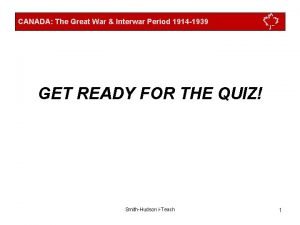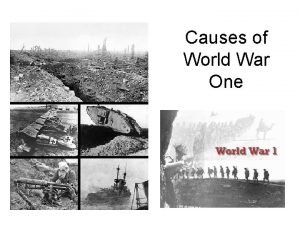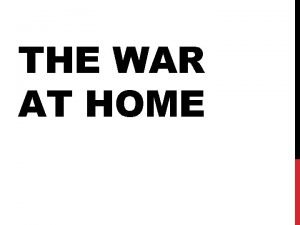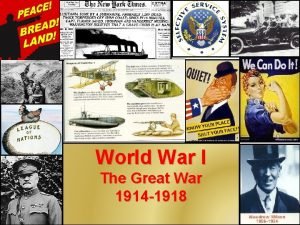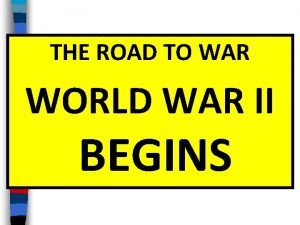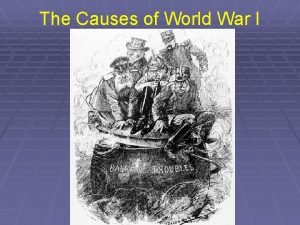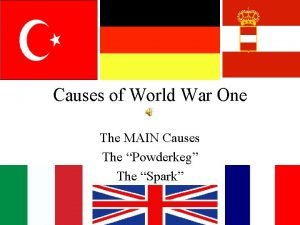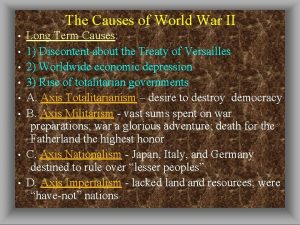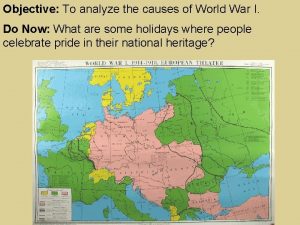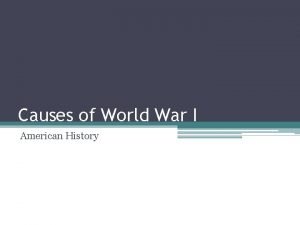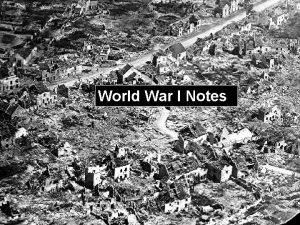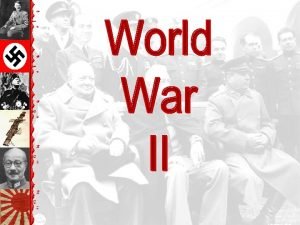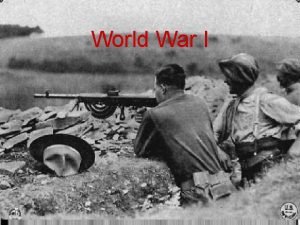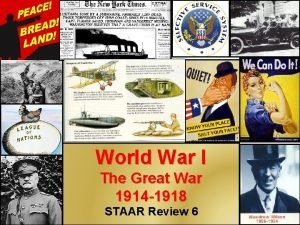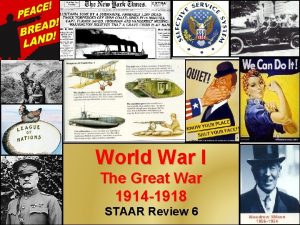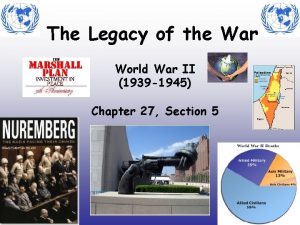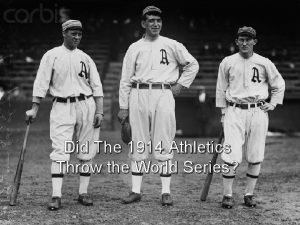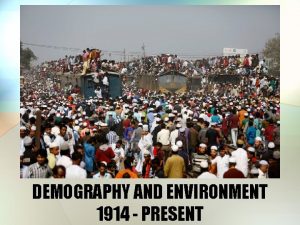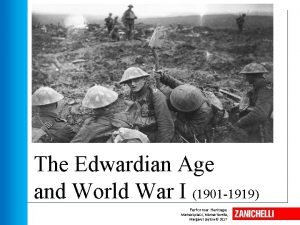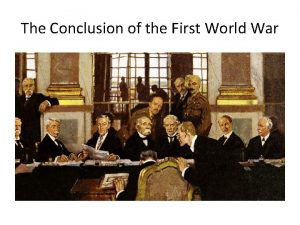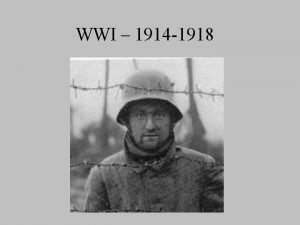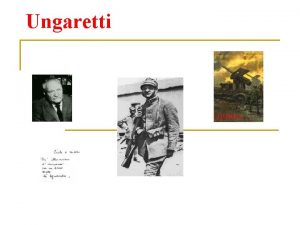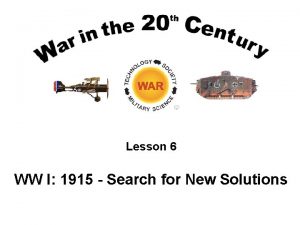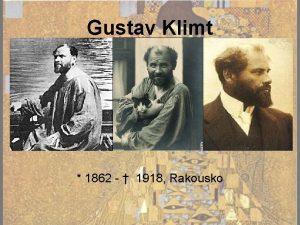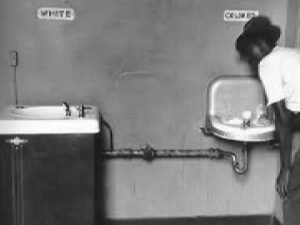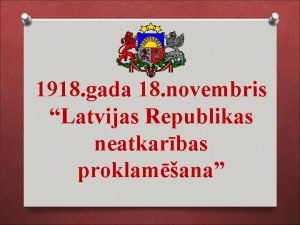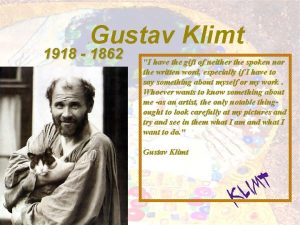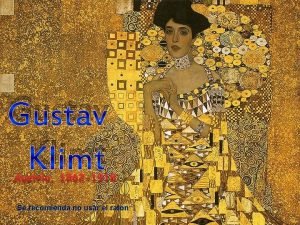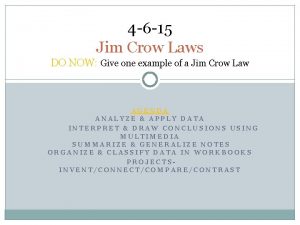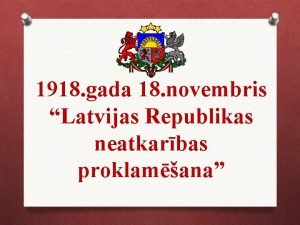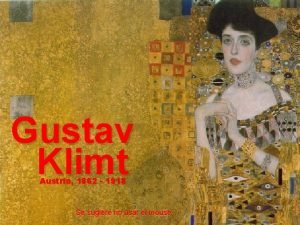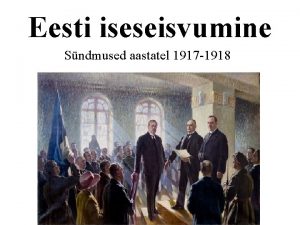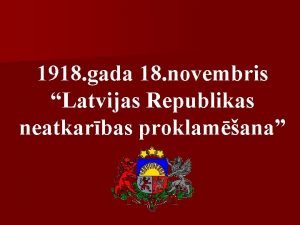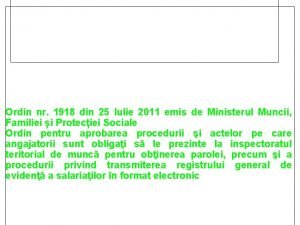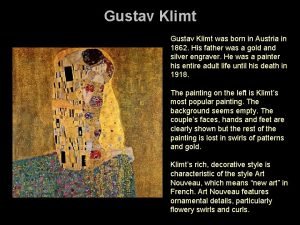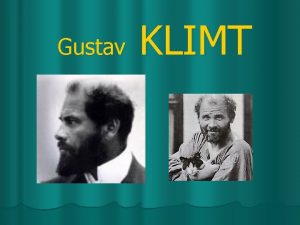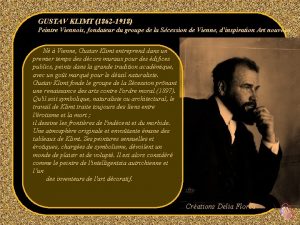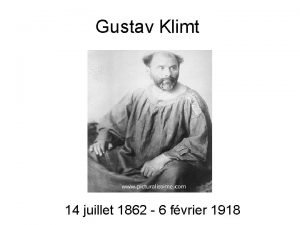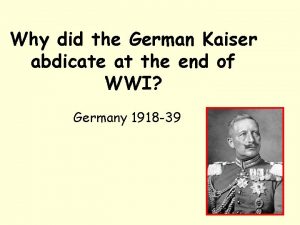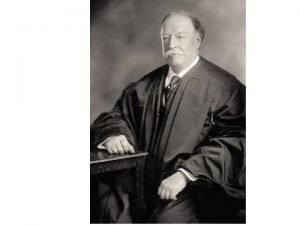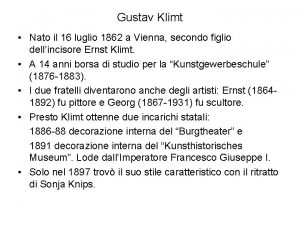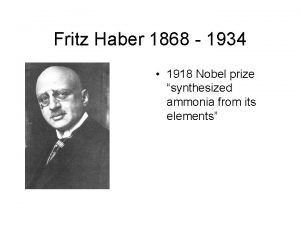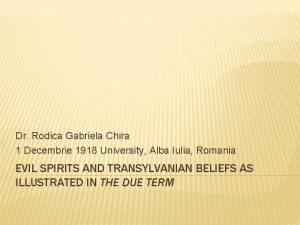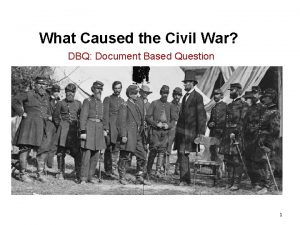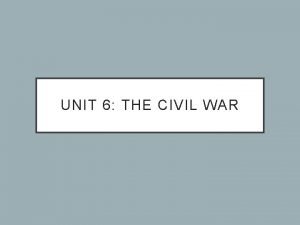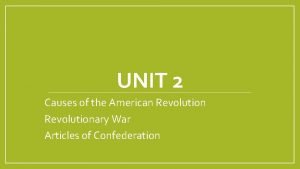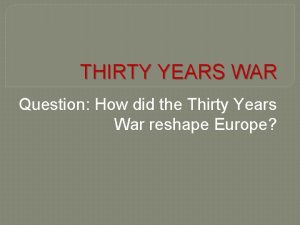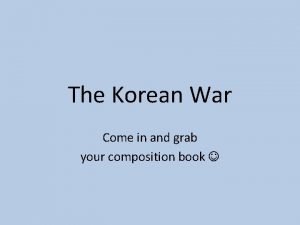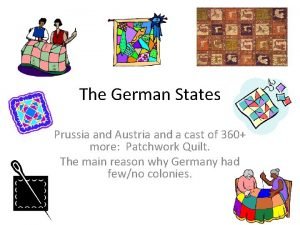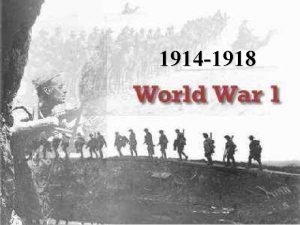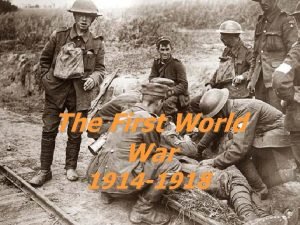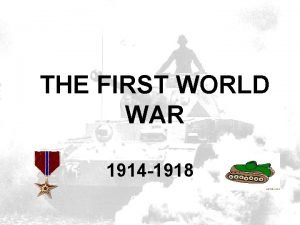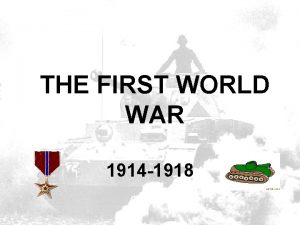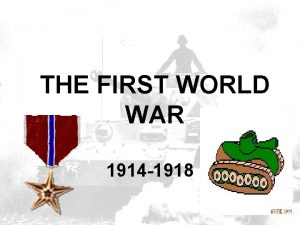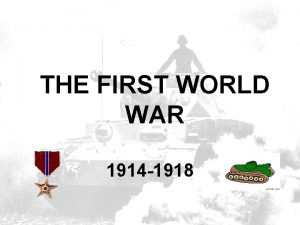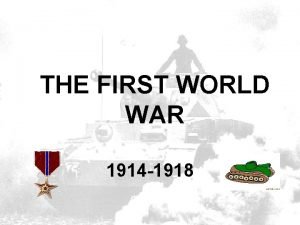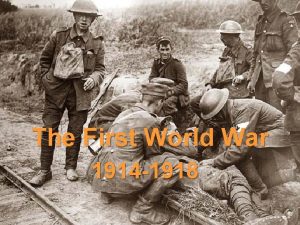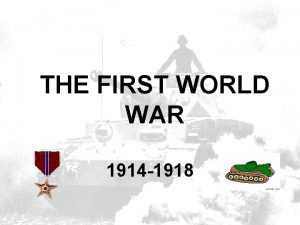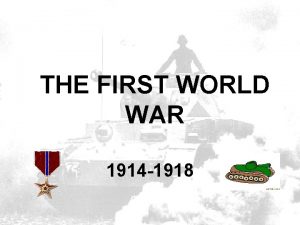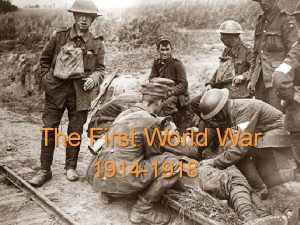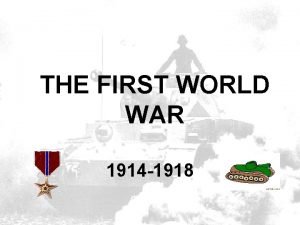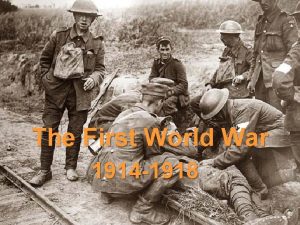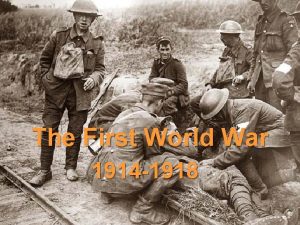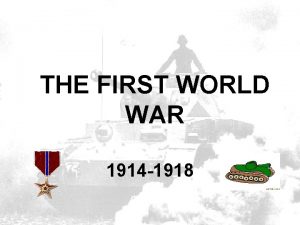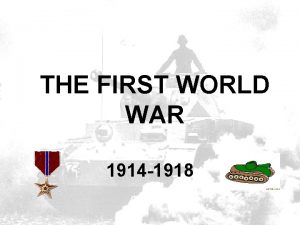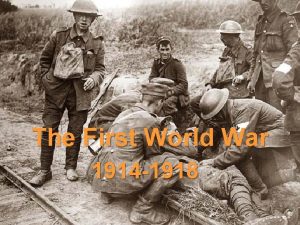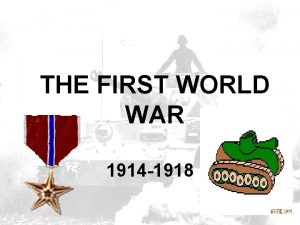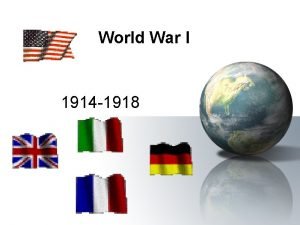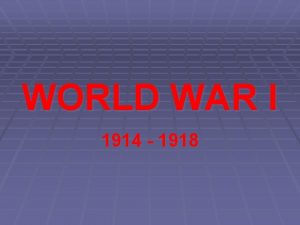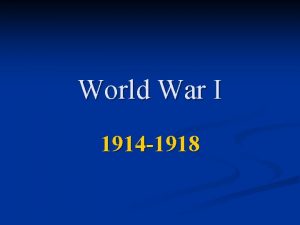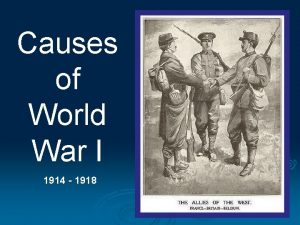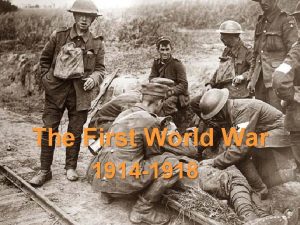THE FIRST WORLD WAR 1914 1918 The Causes































































- Slides: 63

THE FIRST WORLD WAR 1914 -1918

The Causes of the War and US Neutrality

CAUSES OF THE WAR Historians have traditionally cited four long-term causes of the First World War ØMILITARISM – The growth of nationalism and imperialism led to increased military spending ØALLIANCE SYSTEM – By 1907 Europe was divided into two armed camps ØIMPERIALISM – Economic and political control over weaker nations ØNATIONALISM – a devotion to the interests and culture of one’s nation

NATIONALISM § Often nationalist are national elitists, similar to racist, where compromise with a “weaker” power is not possible. §various ethnic groups resented domination by others and wanted independence, such as the Serbians. § Among the greater power, there was a great sense of patriotism sweeping through, inflating national egos


ALLIANCE SYSTEM Ø Alliance system emboldened allies to take unnecessary risks, Making an isolated incident, a global affair TRIPLE ENTENTE ØBy 1907 there were two major defense alliances in Europe Ø The Triple Entente, later known as the Allies, consisted of France, Britain, and Russia FRANCE BRITAIN RUSSIA ØThe Triple Alliance, later known as the Central Powers, consisted of Germany, Austria -Hungary, and Italy (Soon joined by the Ottoman Empire

IMPERIALISM §European nations built empires § Colonies supplied European nations with raw materials and provided markets for goods § As Germany industrialized it competed directly with France and Britain § This allowed for flashpoints of hostilities that create conflict

MILITARISM ØAn arms race struggle (militarism) sows the seeds of conflict. An arms race creates uncertainty, where on power may pre-empt military involvement in order to avoid a lag in the arms race. ØAt a social level, Militarism fosters an acceptance for behavior that makes societies aggressive and nationalistic ØIncrease in spending gives the army more power in government

MILITARISM in Europe Ø As a result of imperialism and competition, European nations increased military spending in the late 19 th and early 20 th century. Ø By 1890. the strongest nation militarily in Europe was Germany Ø Germany had a strong army and built up a navy to rival England’s fleet Ø France, Italy, Japan and the United States quickly joined in the naval buildup

THE SPARK: AN ASSASSINATION Ø The Balkan region was considered “the powder keg of Europe” due to nationalism and competing interests in the area ØAustria-Hungary, which had taken control of Bosnia in 1878, accused Serbia of subverting its rule over Bosnia. Ø In June of 1914, Archduke Franz Ferdinand, heir to the Austrian throne was gunned down by a Serbia radical igniting a diplomatic crisis. The Archduke is assassinated in Sarajevo in June 1914

THE FIGHTING BEGINS Ø The Alliance system pulled one nation after another into the conflict – The Great War had begun Ø On August 3, 1914, Germany invaded Belgium, following a strategy known as the Schlieffen Plan Ø This plan called for a quick strike through Belgium to Paris, France ØNext, Germany would attack Russia Ø The plan was designed to prevent a two-front war for Germany The Schliefflen Plan

THE WAR BECOMES A STALEMATE § Unable to save Belgium, the Allies retreated to the Marne River in France where they halted the German advance in September of 1914 § Both sides dug in for a long siege § By the spring of 1915, two parallel systems of deep trenches crossed France from Belgium to Switzerland § There were 3 types of trenches; front line, support, and reserve § Between enemy trenches was “no man’s land” – an area pockmarked with shell craters and filled with barbed wire British soldiers standing in mud

NEW WEAPONS USED Ø Machine Guns – Guns could now fire 600 rounds per minute Ø The Tank – New steel tanks ran on caterpillar treads Ø Airplanes – Early dogfights resembled duals, however by 1918 the British had a fleet of planes that could deliver bomb loads Ø Poison Gas – mustard gas was used to subdue the enemy

German Soldiers The conditions in these trenches were horrific; aside from the fear of bombardment, soldiers also had to contend with the mud, flooding and disease associated with living in such a harsh environment.

Animals were also susceptible to gas

FIRST BATTLE OF THE SOMME Ø During the First Battle of the Somme - which began July 1, 1916 and lasted until mid-November – the British suffered 60, 000 casualties the first day Ø Final casualties for the First Battle of the Somme totaled 1. 2 million, yet only 7 miles of ground was gained Gas attacks were common features of trench life and often caused blindness and lung disease Ø This bloody trench warfare, in which armies fought for mere yards of ground, lasted for three years

AMERICANS QUESTION NEUTRALITY Ø In 1914, most Americans saw no reason to join a struggle 3, 000 miles away – they wanted neutrality Ø Some simply did not want their sons to experience the horror of warfare Ø German-Americans supported Germany in World War I Ø However, many American felt close to the British because of a shared ancestry and language French propaganda poster portrayed the Germans as inhuman and impacted American attitudes toward the Germans Ø Most importantly, American economic interests were far stronger with the Allies

THE WAR HITS HOME Ø During the first two years of the war, America was providing (selling) the allied forces dynamite, cannon powder, submarines, copper wire and tubing and other war material Ø Both the Germans and British imposed naval blockades on each other German U-boat 1919 Ø The Germans used U-boats (submarines) to prevent shipments to the North Atlantic Ø Any ship found in the waters around Britain would be sunk

THE LUSITANIA and SUSSEX are sank! Ø United States involvement in World War I was hastened by the Lusitania and Sussex disaster Ø The Lusitania was a British passenger liner that 128 Americans on May 7, 1915 when it was hit by a U boat. ØThe Germans claimed the ship was carrying Allied ammunition Ø Americans were outraged and public opinion turned against Germany and the Central Powers May 7, 1915 ØAfter another Ship the Sussex was hit, the German responded with the Sussex pledge, conceding to the Angry Americans.

The N. Y. Times reports on the Lusitania

Sussex Pledge • Passenger ships would not be targeted; • Merchant ships would not be sunk until the presence of weapons had been established, if necessary by a search of the ship; • Merchant ships would not be sunk without provision for the safety of passengers and crew. • The Sussex pledge was therefore rescinded in January 1917

Early Lessons of the War Ø World War I was a total war, involving the governments, economies and populations of participating nations to an extent never seen before in history. ØBlind delusion caused by excessive nationalism. Everyone thought it would be a short, offensive war, where they will win.

The War at Home

1916 ELECTION Ø The November 1916 election pitted incumbent Democrat Woodrow Wilson vs. Republican candidate Supreme Court justice Charles Evans Hughes Ø Wilson won a close election using the slogan, “He kept us out of war” Wilson Ø That slogan would prove ironic because within a few months the United States would be embroiled in World War I

AMERICA EDGES CLOSER TO WAR Several factors came together to bring the U. S. into the war; (Zimmerman note) Encoded message from Germany to Mexico Ø 1) Germany ignored Wilson’s plea for peace, the sinking of four unarmed U. S. merchant ships by German subs Ø 2) The Zimmerman Note, a telegram from the German foreign minister to the German Ambassador in Mexico, proposed an alliance. Germany promised Mexico a return of their “lost territory” in Texas, New Mexico, and Arizona

Zimmerman note intercepted by a British agent and decoded

AMERICA DECLARES WAR Ø A light drizzle fell on Washington on April 2, 1917, as senators, representatives, ambassadors, members of the Supreme Court, and other guests crowded into the Capital building to hear Wilson deliver his declaration of war Ø Wilson said, “The world must be safe for democracy” Ø Congress passed the resolution a few days later.

War Time Powers Ø The entire U. S. economy was focused on the war effort Ø The shift from a consumer economy to war economy required a collaboration between business and government Ø In the process, the power of the U. S. government expanded Ø Congress gave President Wilson direct control over the economy

WAR INDUSTRIES BOARD Ø The War Industries Board (WIB), main regulatory body of the US, encouraged companies to use mass-production techniques Ø eliminate waste by standardizing products ØThe WIB set production quotas ØAllocated raw materials ØApplied price controls ØIndustrial production increased by 20 percent Poster encouraging production

National Labor ØUnder the WIB, industrial production and wages increased 20% Ø Union membership almost doubled during the war years – from 2. 5 million to 4 million Ø To deal with disputes between management and labor, President Wilson set up the National War Labor Board in 1918

Food Administration Ø To conserve food, Wilson set up the Food Administration (FA) Ø The FA declared one day a week “meatless” another “sweetless” and two days “wheatless” Ø Homeowners planted “victory gardens” in their yards Ø Schoolchildren worked afterschool growing tomatoes and cucumbers in public parks Ø Farmers increased production by almost 30% by adding 40 million acres of farmland

Selective Service Act Ø America was not ready for war – only 200, 000 men were in service when war was declared Ø Congress passed the Selective Service Act in May of 1917 Ø By the end of 1918, 24 million had signed up and almost 3 million were called to duty Ø About 2 million American troops reached Europe

RAISING WAR MONEY Ø The U. S. had two major tasks; raising money and convincing the public to support the war Ø The U. S. spent $35. 5 billion on the war effort Ø The government raised about 1/3 of that through an income tax and “sin” taxes Ø The rest of funds was raised through war bonds sold to the public (Liberty Loans & Victory Loans)

PROPAGANDA Ø To popularize the war, the government set up the nations first propaganda agency called the Committee on Public Information (CPI) Ø The CPI persuaded many of the nation’s artists to create thousands of paintings, posters, cartoons and sculptures to promote the war













ATTACK ON CIVIL LIBERTIES Ø As the war progressed, Civil Liberties were compromised Ø Anti-Immigrant feelings were openly expressed especially anti-German. Ø Espionage and Sedition Acts were passed by Congress Ø These acts were designed to prevent anti-war protests but went against the spirit of the First Amendment (Free speech) Ø Socialists and labor leaders were targeted Anti-German hysteria during wartime

SOCIAL CHANGE for African Americans Ø WW I accelerated the Great Migration, population shift for hundreds of thousands of blacks from the south to Northern cities, Chicago and New York ØThey left to escape discrimination and to seek greater job opportunities This African American family settled in Chicago ØIn Addition, 400, 000 blacks joined the military serving in segregated units.

WOMEN IN THE WAR Ø Many women were called upon to take on jobs previously held by men who were serving in the war Ø They became railroad workers, cooks, dockworkers, factory workers, and miners Ø Many women served as volunteers in organizations such as the Red Cross Ø Their service hastened the passage of the 19 th Amendment in 1920 giving women the right to vote

THE FLU EPIDEMIC Ø In the fall of 1918, the United States suffered a home-front crisis when a flu epidemic affected 25% of the population Ø Mines shut down, telephone service was cut in half, factory work was delayed Ø Cities ran short on coffins while corpses lay unburied for as long as a week Seattle, like many other places, became a masked city. All police wore them, as shown in this photo from "The Great Influenza" Ø The epidemic killed as many as 500, 000 in the U. S. before it disappeared in 1919 Ø Worldwide the epidemic killed 30 million people

The Conclusion

FRESH U. S. SOLDIERS JOIN FIGHT Ø After 2 ½ years of fighting, the Allied forces were exhausted Ø One of the main contributions of the Americans was fresh and enthusiastic troops Ø American infantry were nicknamed “doughboys” because of their white belts Ø Most doughboys had never ventured far from the farms or small towns they lived in

AMERICAN WAR HERO Ø Alvin York, a blacksmith from Tennessee, originally sought an exemption from the war as a Conscientious Objector Ø York eventually decided it was morally acceptable to fight if the cause was right Ø On October 8, 1918, armed with only a rifle and a revolver, York killed 25 Germans and (with six doughboys) captured 132 prisoners The man The movie Ø Upon his return home he was promoted to Sergeant and hailed a hero

AMERICAN TROOPS GO ON THE OFFENSIVE Ø When Russia surrendered to the Germans in 1917, it allowed the Central Powers to focus on the Western Front Ø By May, the Germans were within 50 miles of Paris Men of the 42 nd Division during the Second Marne. These men were killed by artillery fire just 5 minutes after this photo was taken Ø The Americans arrived and immediately played a major role in pushing the Germans back In July and August the Americans helped the Allies win the Second Battle of the Marne

GERMANY COLLAPSES; COLLAPSES, THE GREAT WAR ENDS Ø On November 3, 1918, Germany’s partner, Austria. Hungary, surrendered to the Allies Ø That same day, German sailors mutinied against their government Ø Other revolts followed, and Germany was too exhausted to continue Ø So at the eleventh hour, on the eleventh day, of the eleventh month of 1918, Germany signed a truce ending the Great War ends 11/11/18

SECTION 4: WILSON FIGHTS FOR PEACE ØWilson’s plan was called the “Fourteen points” Ø Included in his “points” were: ü No secret treaties ü Freedom of the Seas ü Reduction of arms ü Less colonialism ü League of Nations to Wilson’s 14 points in his own short hand

ALLIES REJECT WILSON”S PLAN, SIGN TREATY ØThe Big Four leaders, Wilson (U. S. ), Clemenceau (France), Lloyd George (England), and Orlando (Italy), worked out the Treaty’s details. Ø Wilson’s plan for peace would be rejected by the Allies except the establishment of the League of Nations ØOn June 28, 1919, the Big Four and the leaders of the defeated nations gathered in the Hall of Mirrors at Versailles and signed the Treaty of Versailles Hall of Mirrors

TREATY OF VERSAILLES Ø The Treaty broke up the Austro. Hungarian Empire and the Ottoman Empire empires Ø The Treaty barred Germany from maintaining an army Ø Required Germany to give Alsace-Lorraine back to France Ø Germany had to pay $33 billion in reparations to the Allies ØEstablished the League of Nations ØGermany had to admit starting the war (war guilt) The Big Four met at Versailles


THE WEAKNESS OF THE TREATY The harsh treatment of Germany prevented the Treaty from creating a lasting peace in Europe Ø The Treaty humiliated the Germans by forcing them to admit sole responsibility for the war (War-Guilt Clause) Germans felt the Versailles Treaty was unfair Ø Furthermore, Germany would never be able to pay $33 billion in reparations

DEBATE OVER TREATY AT HOME Ø In the United States, the Treaty was hotly debated especially the League of Nations Ø Conservative senators, headed by Henry Cabot Lodge, were suspicious of the Leagues’ joint economic and military commitments Ø Many wanted the U. S. Congress to maintain the right to declare war Ø Ultimately, Congress rejected U. S. involvement in the very League the U. S. President had created The U. S. never did join the league

Home Lessons ØWorld War I had strengthened power and of the Federal government. ØGovernment regulation of the economy can successfully lead to wartime production. ØThe shortage of labor and rise in demand of American goods overseas accelerated social change, for blacks and women. ØFailure of the US to join the league indicated the tendency of the US to support its isolationism.

The Legacy of WWI Abroad ØThe destruction and massive loss of life severely damaged social and political systems, a breeding ground for extremism. ØPunitive measures in the Treaty of Versailles would lead to an ongoing sense of resentment and bitterness during a time of a great economic crises. WWI 1914 -1918 22 million dead, more than half civilians. An additional 20 million wounded. ØFailure of Idealism. At the root of the international crises was the failure of the League to fulfill its overarching objective, to stop international aggression.
 1914 1918
1914 1918 Causes of first world war
Causes of first world war Who reorganized the war industries board in 1918
Who reorganized the war industries board in 1918 Causes of world war 2
Causes of world war 2 Ww2 causes
Ww2 causes Main causes of world war 1
Main causes of world war 1 What were the m.a.i.n. causes of wwi
What were the m.a.i.n. causes of wwi Ww2 long term causes
Ww2 long term causes Causes of world war 1 mania
Causes of world war 1 mania Causes of world war 1 mania
Causes of world war 1 mania M.a.n.i.a ww1
M.a.n.i.a ww1 Causes of ww2
Causes of ww2 Causes of world war 2
Causes of world war 2 Main causes of world war 1
Main causes of world war 1 4 causes for ww1
4 causes for ww1 Causes of world war 1
Causes of world war 1 Causes of ww2
Causes of ww2 Pstuffy bunny
Pstuffy bunny Population of the world 1914
Population of the world 1914 Why was the civil war considered the first modern war
Why was the civil war considered the first modern war The edwardian age and world war i zanichelli
The edwardian age and world war i zanichelli Conclusion of ww1
Conclusion of ww1 Ultimate cause of behavior
Ultimate cause of behavior Altruistic behavior
Altruistic behavior 1918 europe map
1918 europe map Rzeczpospolita trojga narodów
Rzeczpospolita trojga narodów Soldati ungaretti data
Soldati ungaretti data Varför kallas perioden 1918-1939 för mellankrigstiden
Varför kallas perioden 1918-1939 för mellankrigstiden Ft17
Ft17 1918-1862
1918-1862 Jim crow character
Jim crow character 18 novembris 1918
18 novembris 1918 What is the red scare
What is the red scare 1877 to 1918 cloze notes
1877 to 1918 cloze notes 1 decembrie proiect
1 decembrie proiect 1918-1862
1918-1862 1918-1862
1918-1862 1918-1862
1918-1862 Louisiana 1918 poll tax receipt
Louisiana 1918 poll tax receipt 1918 18 novembris
1918 18 novembris 11 listopada 1918 piosenka tekst
11 listopada 1918 piosenka tekst 1918-1862
1918-1862 Jaan poska
Jaan poska 1918 18 novembris
1918 18 novembris Gustv klimt
Gustv klimt Joodse organisatie ci
Joodse organisatie ci Revisal hg 500 din 2011 download
Revisal hg 500 din 2011 download Lịch sử hà nội từ năm 1802 đến năm 1884
Lịch sử hà nội từ năm 1802 đến năm 1884 1918-1862
1918-1862 1918-1862
1918-1862 1918-1862
1918-1862 1918-1862
1918-1862 Why did the kaiser abdicate
Why did the kaiser abdicate Hammer v. dagenhart
Hammer v. dagenhart Nato 1862
Nato 1862 1918 nobel prize winners
1918 nobel prize winners 1 decembrie 1918 university
1 decembrie 1918 university What caused the civil war dbq
What caused the civil war dbq The cause of the civil war
The cause of the civil war Causes of the american revolutionary war
Causes of the american revolutionary war Thirty years' war causes
Thirty years' war causes What caused cold war
What caused cold war Causes of the korean war
Causes of the korean war Thirty years war
Thirty years war
